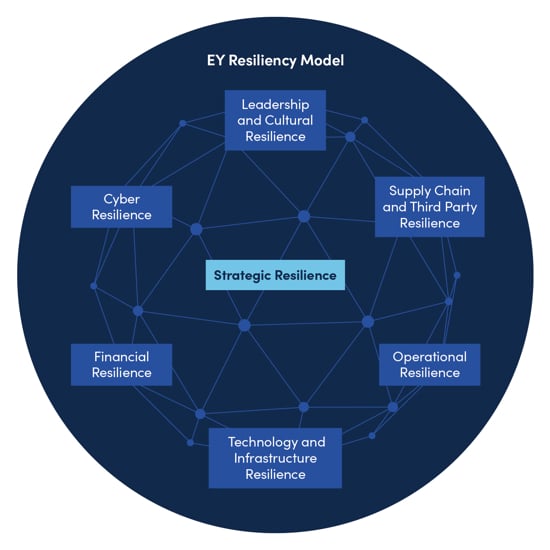Governance Surveys
Directorship Magazine

Getty Images/Morsa Images
Online Article
Why Boards Need to Add Strategic Resilience to the Agenda
Boards can take a cross-functional approach to resilience to avoid crisis mode and enable growth during periods of disruption.
“All the management teams of my companies are in crisis mode these days,” one director told us as several heads nodded vigorously in agreement around the table at a recent event. This is a refrain that has echoed throughout the roundtables we have hosted over the past few months.
It comes as no surprise to see many executive teams mired in crisis management mode. The current business environment is characterized by rapid changes, from economic fluctuations and geopolitical tensions to technology disruption and regulatory revisions, and business leaders feel pressure to react quickly. It is becoming difficult for boards and management teams to anticipate and articulate expectations for both the near term and long term. Naturally, the reaction for many is to default to crisis mode.
However, in an environment in which the next crisis or disruption is waiting around the corner, the typical ad hoc, siloed approach that comes with crisis mode will inhibit long-term growth by keeping organizations trapped in a reactive mindset. This can lead to short-term decisions, misdirection of resources, and missed opportunities.
A Better Path to Growth
What if, instead, leaders embrace a strategic approach that is designed to continuously respond to changing circumstances, where functions are aligned to what is essential and are flexible and collaborative as needed? This is the emerging concept of strategic resilience.
Unlike traditional resilience, which is about localized crisis management and business continuity, strategic resilience aligns enterprise-level processes, resources, governance, and culture across functional areas to enable adaptability and flexibility, as illustrated in the framework below. This model also calls for integrated risk management with a unified approach that creates a common language for and understanding of risk that enable the right decisions and actions to be made across businesses and functions.

Source: Ernst & Young LLP
Strategic resilience is the sum of key parts, where critical elements of the organization work together to coordinate communication, information, and planning. These pillars include:
Supply chain and third-party partnerships. With the increased reliance on third and fourth parties, it is essential to manage the supply chain and build strong partnerships to withstand and recover from disruptions, and shift as needed.
Operations. This is the foundation of any good resilience program. Operational resilience should evolve beyond the traditional “prepare and respond” approach to a more holistic “bend, don’t break” approach that can flex and adjust.
Technology and infrastructure. Technology resilience helps confirm that the digital infrastructure, applications, and platforms are future-proof and adaptable to emerging risks.
Finance. Financial resilience enables companies to adapt to economic uncertainty by optimizing capital structure, managing liquidity, and leveraging scenario planning.
Cybersecurity. With cyber risks growing in complexity and threatening companies, organizations must shift from a reactive to a proactive stance by integrating cybersecurity into business resilience.
Leadership and culture. Leaders and culture should adapt to withstand and thrive amid disruptions with flexibility, innovation, and collaboration. The ability to inspire teams, drive change, and maintain morale is a critical component of enterprise resilience.
Boards Light the Way Forward
Given the complexity of and the governance and capital allocation that go into true strategic resilience, directors have a crucial role to play in several areas. Boards can start by taking the following actions:
- Align resilience to organizational priorities. Start with the value chain of the business. What drives revenue and is most critical to customers and stakeholders? What can enable or threaten these drivers? How might critical dependences in technology play a role?” Answering these questions helps to validate that the company is thinking not just in terms of defense but also offense in alignment with its strategy for growth.
- View risk dynamically to keep pace with disruption. Enterprise risk assessments have always been on the board agenda, but today’s volatile environment calls for more dynamic reporting with external current analysis and an identification of trigger events. Additionally, viewing risk holistically across the enterprise and understanding and reviewing the interdependencies between risks should become part of ongoing conversations.
- Guide management to appropriate trade-offs. Often, management teams make decisions about resources and redundancies that may be critical but get subsumed in cost cutting. Strategic resilience comes with costs and benefits that should be made more explicit for the board so directors can guide the strategic trade-offs needed.
- Assess leadership and cultural resilience. Understand how and whether current leaders and those in the succession pipeline are equipped for the organization’s changing circumstances and needs. While directors are beginning to consider the implications as they observe their management teams, they will need to accelerate difficult discussions.
Additionally, while the questions below may seem straightforward, boards that ask these of management can open the door to very different and productive discussions:
- How resilient is our strategy?
- How resilient are our products and services?
- How resilient are our operations?
- How resilient are our people?
Strategic Resilience into the Future
Strategic resilience is not easy. It is a complex and developing discipline that calls for cross-enterprise collaboration and adaptation with intention and focus.
Given this environment in which disruption comes from many angles, building this discipline is essential and must frame board discussions. One final consideration for the board agenda is to incorporate future-mapping into resilience discussions and exercises at this year’s strategy retreat; this will enable boards to anticipate what is to come and provide organizational alignment to create opportunities.
It has the potential to position organizations for a bright future during these uncertain times. Combining future-trend mapping with a strategic resilience practice can be a game changer for any organization.
EY is a NACD sponsor, providing directors with critical and timely information, and perspectives. EY is a financial supporter of the NACD.
The views expressed in this article are the author's own and do not represent the perspective of NACD.

Cigdem Oktem is a recognized thought leader on governance, risk, and strategy issues and has served as a trusted advisor to boards and C-suite executives for the past 15 years in various roles. Oktem is a director with the EY Center for Board Matters.
Registration Now Open for
NACD Directors Summit™ 2026
Register Early and Save $2,000
October 11-14, 2026
The Gaylord National Harbor | Washington, DC Area

